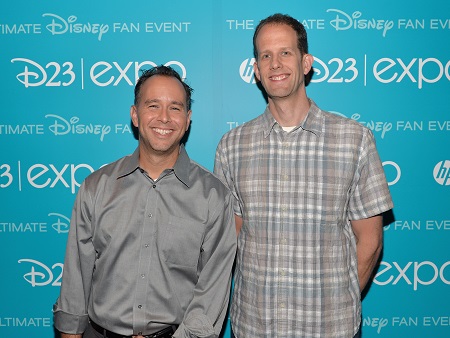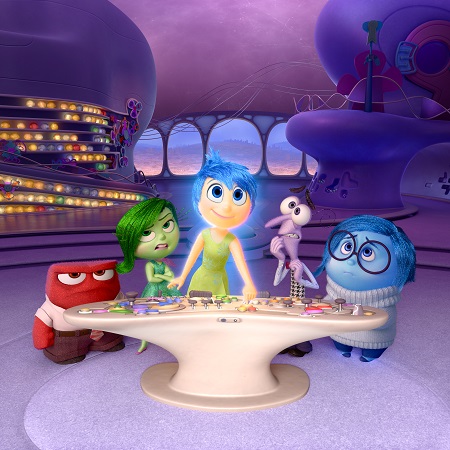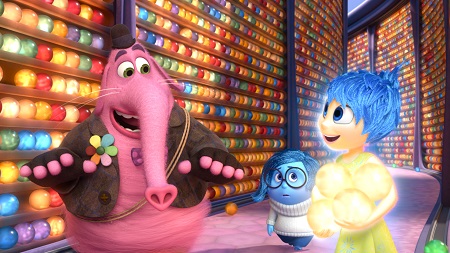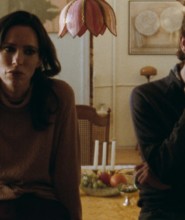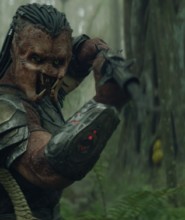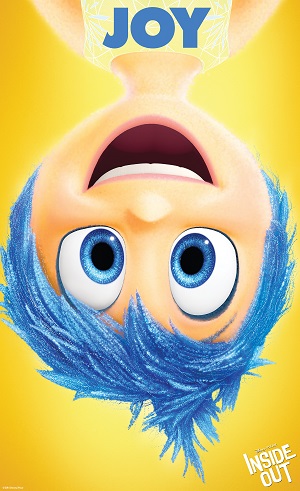
“Inside Out” – Interview with Pete Docter & Jonas Rivera
by Sara Michelle Fetters - June 26th, 2015 - Film Festivals Interviews
a SIFF 2015 interview
Going Inside Out
Peter Docter and Jonas Rivera on Bringing Pixar’s Latest Marvel to Life
As of right now, Inside Out is my favorite film of 2015. The tale of an 11-year-old girl, Riley, as told entirely by the five dominant emotions – Joy, Sadness, Anger, Fear and Disgust – working with one another for control residing inside her brain, the movie is a marvelously entertaining journey into the psyche. It is a fun, funny and visually resplendent human adventure that shows what it is to grow and evolve, depicting how consciousness and personality are attained as we progress from birth, to adolescence, into our teenage year and eventually into adulthood.
During this year’s Seattle International Film Festival I had the privilege to sit down with director Pete Docter and producer Jonas Rivera to discuss the film, the thought process behind it and the five year journey to its eventual unveiling to mass audiences of all age groups. Here are some of the highlights from that conversation:
Sara Michelle Fetters: I don’t know how much stock you’ll place in this, how much you’ll believe it, but I was talking to a fellow critic who attended the Cannes Film Festival and they were adamant that had Inside Out but eligible it would have won the Palme D’or, that your movie was without question the festival’s most popular attraction amongst the critics.
Jonas Rivera: That’s really cool to hear.
Pete Docter: That’s awesome.
Jonas Rivera: I mean, it was certainly a great response [from the audience], but you should hear what people tell you going in. You’re told to never expect the best.
Pete Docter: They warn you, the publicity folks, those running the festival; Cannes is a world cinema marketplace. They let you know what they think. Poor Gus Van Sant. They kind of let him hear it a day or two before Inside Out debuted. So we just walked in to the screening thinking, let’s behave, let’s be cool and hope they like it, and then they gave us a really warm response. It was wonderful.
But, we were asked to go with Inside Out. We were asked to go with Up in 2009, so being asked to attend [Cannes] twice is a really great honor. But winning? If we had been in competition? It’s really cool to hear that and I’m glad people are enjoying the movie but we sort of don’t breed the film to fight. Winning awards isn’t part of the equation. Being able to make a movie, to take it to [Cannes], to show it at a place that seems to appreciate and love film, that’s the biggest win. I think the biggest thing out of Cannes is we don’t think of these movies as conventional animated movies. We just think of them as films that happen to be animated, so being at the Cannes Film Festival is wonderful because it means that the cinematic world sees that, too.
Sara Michelle Fetters: What I love about your films, this one just being the latest case in point, is that you trust kids. While you’ve obviously made this movie for everyone, for audiences of all ages, but at the same time you seem to understand children can handle some pretty deep, fairly complex subjects, oftentimes better than their own parents.
Pete Docter: We’re pretty lucky in that we work with people like John Lasseter and they feel the same way. They’re smart. Not only do they get the technical stuff, the complexities involved with giving these kinds of films life, but they also understands the language of children. With kids, what’s the first language they speak? Well, that’s emotion. Right? Even if they don’t understand the specifics of what is being talked about, if they see a character is upset or fearful or happy, they respond to that. I think everyone at Pixar, I think we all get, understand and appreciate that fact.
Jonas Rivera: We start off selfishly ignoring that there’s any difference [between adults and kids]. We just set out to make the kind of movie we would want to go see. You’re right, though, and John Lasseter is a champion of that sort of thing, trusting kids will go along for the ride even if the subject matter in theory might seem to be above their level of understanding. The reality? More often than not it isn’t.
Pete Docter: The studio [Disney] is great at supporting us and letting us work that way. But, then, I think they have a long history of that, don’t they? One that goes all the way back to Walt himself.
Sara Michelle Fetters: Talk to me about the writing process. How do you structure characters that are based entirely around a single emotion? When you’re putting all that together, what do you keep peeling away to make sure you stay true to that emotion yet at the same time are still able to craft a story that is compelling, complex and one audiences will find worthy of their attentions?
Pete Docter: That’s the trick. Early on, we named the characters other than what they represented. I felt if you called them “Sadness,” if you called them “Anger,” than the subtext becomes the text and that’s not a good place to be as a writer. You always want to have a couple layers to things.
Turns out, that was confusing to people. I was wrong on that. But, also, early on I think we made them [the characters] pretty one-note. We had to give complexity and nuance to them, especially with Joy. I mean, we can represent that physically; she’s got blue hair and a green dress so she’s probably the most wide, the most well-rounded as a character as the little elements essential to the others are more easily identifiable in her. But we really wrote the characters to their core emotions but understood elements of other emotions are what make anger or joy or sadness or disgust what they ultimately are. Sometimes we wrote them too broadly, and we’d have to step back and ask ourselves, who’s the green one again? What’s going on with that red guy? We knew we had to go back to the core elements behind who each of them are, compose some more lines specific to Disgust, essential to Fear. It was definitely a process back and forth.
Sara Michelle Fetters: I’m glad you brought that up. That was one of the things I noticed. Almost all of the characters, all of the emotions, have some variation on a color from at least one of their compatriots. Disgust has that purple neck scarf, Fear that almost red – but not quite – bow tie. They’ve all got facets of the other emotions, even if they don’t necessarily realize that they do. It’s like they’re all growing up at the same time their host, 11-year-old Riley, is.
Pete Docter: If you look at Mom and Dad’s emotions, they’re much more all uniform, especially Mom’s. At the beginning of life it’s more like the Wild West, all the emotions shooting off in their own way. As they get older, they get more sophisticated, more in touch with their counterparts. The emotions have to learn to work together.
Sara Michelle Fetters: How much fun is it to play in a sandbox such as this? Where you get to come up with such a crazy sounding idea and then subsequently are given the freedom to just go nuts and see where your ideas lead?
Jonas Rivera: It’s unbelievable. We have the greatest jobs in the world. It’s hard. We take it very seriously. Pete pitches this idea to John [Lasseter] about a little girl’s mind and then they say yes so that means we spend the next five years trying to make it work, making the film with all of our best friends each of us with a common goal. If you do the job right you make something that might actually be important to people. That’s really, really cool.
Sara Michelle Fetters: Casting with every film is important. That just goes without saying. In an animated film, because the actors have to make it all work primarily with their voice, and I get as animators you do get to watch them give these performance and that does undoubtedly influence the compositions to a certain extent, if you don’t cast a film like this correctly how much trouble are you in?
Jonas Rivera: It might not work. Plain and simple. It might not work. It’s a big part of it. There are so many great actors, though, and what we try to do is disembody them and just listen to the voice and not be charmed by say how beautiful or charming someone like Mindy Kaling is. You just listen to the voice.
Pete does an amazing job of creating context and directing the actor in a way that leads them where we want to go. That helps a lot. But, yeah, the right or wrong voice, that’s the whole thing right there. I often think about Baloo the Bear in The Jungle Book. Anyone else other than Phil Harris? It’s not the same movie. But every producer or director will tell you this. Casting is such a fragile thing. It just is.
Sara Michelle Fetters: But the freedom you give your cast members to create and to inspire. I was sitting through the credits and I noticed that you have three additional dialogue/story credits that you hand out, two of them to Amy Poehler, who plays Joy, and Bill Hader, who’s Disgust.
Pete Docter: In both their cases, they sat at a writing table with us trying to figure this film out. In Bill’s case, I think worked with us for close to a week and a half. He would sit in the writer’s room, discuss things with co-writer [Josh] Cooley, pace around and touch up sequences. A lot of stuff that didn’t seem huge but really was, they’d come up with something around that.
I mean, we’d give them specific tasks, stuff like “Dream Production,” and we’d know in our heads that this should be a really funny scene. Then why wasn’t it funny, yet? What were we not seeing? Bill would come up with little ideas, stuff that seemed so simple but wasn’t as obvious as you might thing, stuff like cutting up to Fear as the dream is going on, see Fear’s reaction. That wasn’t there in our original take, and Bill brought that in and suddenly you had a viewing hole to see all the weirdness. If we’re with Fear watching this it suddenly got funny.
Amy was the same thing. The first day with her we didn’t even have a mic. We just sat in the hotel room and went through the whole script. The structure was all there but she just kept finding all these places to add things, making it funnier but also finding ways to make it more emotional, give it additional depth. There’s tons of stuff that those guys added.
Sara Michelle Fetters: Then there are the animators.
Pete Docter: Exactly. That was the other point I wanted to bring up. I’ve got to give a plug to the animators. The animation is the other half of all of this. We lean on them a lot for physical stuff. Stuff that the actors don’t have control of. Gestures. Expressions. There’s a lot of information that you can pick up visually. They’re responsible for the majority of that.
Sara Michelle Fetters: Back to the actors for a second. Richard Kind. Plays the imaginary friend Bing Bong. He’s fantastic! It’s an extraordinary performance, like Eddie Murphy in Mulan or Shrek, or Robin Williams in Aladdin.
Jonas Rivera: He’s so good.
Pete Docter: And he was that good right off the bat. Usually what happens is, you cast someone, then you record, but then as a writer you have to then adjust the way you write to fit what they’re doing. The vice-versa applies as well. You learn what one another’s processes are and it just gets better and better as you go along.
Richard, the first recording session, he came out of the gate and we were floored. So much of that stuff made it into the movie. One take. His first pass. It was amazing.
Jonas Rivera: I had one of the best moments during the whole five years of making the movie with Richard. It was one of our later recording sessions with him and we were having a cup of coffee and I asked him if he’d read the whole script all the way through. And he was like, in his patented Richard Kind sort of way, “I did, and I have to tell you something, I’ve read through these notes and I’ve read through the script and I know the movie and I think it’s glorious and, this morning, it dawned on me…I’m the Wizard of Oz with this.” Wow. What a cool thing to hear. It was just a really nice comment to hear from such a respected actor.
Sara Michelle Fetters: And I’m guessing you could say the same thing about Amy. She’s an acclaimed actress. She’s won Emmys. She gets recognized everywhere that she goes. I just have this, if you’ll excuse me for saying, fear that people will just say something along the likes of, yeah, she’s terrific, but it’s just an animated movie so who cares. Will they recognize the complexity of all she’s delivering? Will they notice just how amazing her work with Phyllis Smith, who plays Sadness, is? I feel like they won’t, and that just makes me feel terrible.
Pete Docter: Yeah. I hear what you’re saying. I think that, of everything on the film, writing for Joy was the most difficult. Finding who that character was, that was really hard. As such, Amy was the last person to be cast, and we were pretty honest about how much trouble we were having. Someone who is just always positive? You kind of just want to smack them. You don’t take them seriously. You don’t feel as if there is a depth to that character. And Amy, Amy just looked at us and said, “I think I can help you there.”
She was very self-knowledgeable. She played the line really dead-on. How far can you go with enthusiasm but not be saccharine? Not be annoying? She’s always knew were that line was. [Joy’s] the driver of the movie. Everybody else doesn’t want to take the wheel, especially Sadness, and she spends the majority of the movie with her. You know the first rule of improv where you never say no? Sadness says no through the whole movie. Amy had to work off of that every step of the way.
Jonas Rivera: I think the actors in an animated movie are oftentimes shocked by just how hard it is. I mean, Tom Hanks, who over the course of making Toy Story won Academy Awards for Philadelphia and Forest Gump. But he once said, voicing Woody was one of the hardest acting jobs he had ever had. It was exhausting. There is no context. There are no costumes. You just have to pull of these performances. But, I mean, great actors do great work, no matter what the difficulty.
Sara Michelle Fetters: And yet, an actor in an animated movie will never be nominated for an Academy Award no matter how worthy the performance might in fact be.
Jonas Rivera: I don’t know. I mean, listen, I’m with you, it’s frustrating, but I don’t think anybody ever thought an animated movie would be nominated for Best Picture, and it happened with Beauty and the Beast and then it’s happened again twice more. Maybe slowly but surely people are starting to see the craft a little bit differently. I’m with you on the level of frustration but I’m also hopeful that maybe if things continue as they have this could possibly change.
Sara Michelle Fetters: At the end of the day, I think we can assume kids are going to go nuts for this film, but audiences in general, when they’re walking out of Inside Out, what do you want them to be feeling? What do you hope they’re talking about?
Pete Docter: The thing I felt at the crew wrap party; you make the film, you struggle with it, you spend your entire time analyzing, so it wasn’t until I saw it with the crew I could feel the movie, I stopped trying to fix things and just sat there watching it; was that you go through this wonderful catharsis ending on a positive and it just felt so comfortably filling to me. You’ve been through this big experience, and I would hope that the audience has this sense of real emotional filling but also at the same time it gives them something to take home and to think about. Maybe it opens the door as to how a family thinks about themselves and about one another. About that process. That would be pretty cool.
